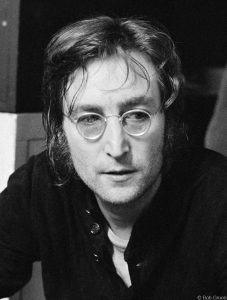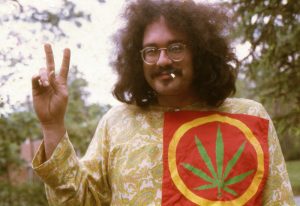
On February 4, 1972 – 47 years ago today – Senator Strom Thurmond of South Carolina sent a memo to John Mitchell, the Attorney General of the United States, in which he demanded that John Lennon be deported!
Why would the not very nice Mr. Thurmond want to do such a thing to nice Mr. Lennon?
Therein lies a remarkable story!

The story begins with the poet, cultural revolutionary, political activist and pothead John Sinclair, who was born in Flint, Michigan in 1941. Sinclair was the chairman of the “Rainbow People’s Party” of Ann Arbor and a founding member and chairman of the “White Panther Party” (which he created in support of the Black Panther Party). He was, by every measure, one of the major “hippie-dippy agitator-types” operating during those troubled days of unrest over the Viet Nam War.
“The Man” (meaning the law enforcement community) decided that Sinclair needed to be silenced. A sting operation was put together, and on January 27, 1967 Sinclair was arrested after passing two joints (marijuana cigarettes, for you youngsters) to two undercover Detroit narcotics police: Patrolman Vahan Kapagian and Policewoman Jane Mumford Lovelace.
The trial that followed was marked by what are now referred to as “irregularities.” The upshot: Sinclair was sentenced to ten years confinement at the state prison in Jackson, Michigan. Sinclair requested an appeal; the request was denied.
10 years for 2 joints. Clearly, the sentence was politically motivated. Sinclair writes:
“The powers-that-be in Michigan had it in for me. They didn’t like what we were doing, establishing an alternative community, defying their authority, smoking grass. They fixed on me because I was the most outspoken, and also because somehow I was successful in bringing young people around to my way of thinking.”
Sinclair immediately became a cause celeb for the counterculture. Sinclair’s wife Leni and his brother David organized concerts and rallies; they enlisted the help of celebrities, including the beat poet Allen Ginsburg, Jane Fonda, and the anarchist Yippie Abbie Hoffman.

(Hoffman, for one, made quite a scene at the Woodstock Festival/lovefest on Sunday August 17, 1969. He jumped on stage during a set by The Who, grabbed a microphone and began making an impassioned pitch for Sinclair before Pete Townshend smacked him on the head with his guitar and chased him from the stage!)
The climax of the “free John Sinclair” movement occurred on December 10, 1971 when the “John Sinclair Freedom Rally” was held at the University of Michigan, Ann Arbor’s Crisler Arena. The rally was huge. It featured speeches by Allen Ginsburg, Abbie Hoffman, Jerry Rubin, Black Panther Party chairman Bobby Seale, the radical priest Father James Groppi and others; and it featured performances by, among others, Stevie Wonder, Phil Ochs, Pete Seeger, Archie Shepp, and Roswell Rudd. But the climax of the event was the appearance – at 3 am in the morning on December 11 (things were running late) – of John Lennon and Yoko Ono. The couple – who had donated their $500 appearance fee to “the John Sinclair Freedom Fund” – sang about the Attica uprising, about Northern Ireland, and about women’s liberation. They closed their set with a song Lennon had written for the event about John Sinclair:
“It ain’t fair, John Sinclair
They gave him ten for two
What else can Judge Colombo do?
Gotta gotta gotta set him free.”

On December 12, 1971, three days after the rally, the Michigan Supreme Court ordered that Sinclair be freed. Three months later, on March 9, 1972, the Michigan Supreme Court reversed Sinclair’s conviction. Sinclair was not just free but his record was clean and he was now well-nigh untouchable.
The same could not be said for that seditious foreign national John Winston Lennon (1940-1980).
Lennon’s appearance at the “John Sinclair Freedom Rally” put him at the very forefront of the anti-Nixon, anti-Viet Nam War movement. And unlike such professional revolutionaries as Jerry Rubin and Abbie Hoffman, whose appeal was limited to fellow protesters, Lennon’s appeal – and potential influence – was unlimited. With a presidential election approaching in November, 1972, and with the voting age in the United States just having been lowered to 18, John Lennon was suddenly perceived as a genuine threat to the re-election of President Richard Nixon.
And perhaps he was.
At the time of his appearance at the Sinclair rally, Lennon was planning what he called an “anti-Nixon tour”: a tour that would take him across the United States during the summer of 1972, arriving in San Diego, California in time for the Republican National Convention in that fair city in August.
OMG: what to do about John Lennon? A sting operation on the lines of the one that got John Sinclair was out of the question. So it was that Senator Strom Thurmond suggested on February 4, 1972 – 47 years ago today – that John Lennon be deported, writing that “deportation would be a strategic counter-measure” against Lennon. Thurmond claimed that Lennon’s deportation was justified by his 1968 conviction on a misdemeanor charge of hashish possession in London, because United States immigration law at the time banned the admission of anyone convicted of a drug offense.
Background

James Strom Thurmond Jr., who lived from 1902 to 2003, was for 48 years a senator from the state of South Carolina: from 1954 to 1964 as a Southern Democrat (or “Dixiecrat”), and then from 1964 to 2002 as a Republican. Whatever were Thurmond’s positive traits – he was, for example, a highly decorated World War Two veteran – he was also a quintessential Southern racist. As Governor of South Carolina in 1948, he was horrified when President Harry Truman ordered an end to racial discrimination in the United States Army, the drafting of federal anti-lynching laws, and the enactment of legislation eliminating state poll taxes.
So dismayed was Thurman that he ran against Truman in 1948 as a third party candidate, telling his cheering supporters in one speech:
“I wanna tell you, ladies and gentlemen, that there’s not enough troops in the army to force the Southern people to break down segregation and admit the Nigra [sic] race into our theaters, into our swimming pools, into our homes, and into our churches.”
The election did not go particularly well for Thurmond, who carried 2.4% of the vote.
As a senator, he opposed the Civil Rights Act of 1957; the Civil Rights Act of 1964 (which outlawed discrimination based on race, color, religion, sex, or national origin); and he opposed the Voting Rights Act of 1965 (which aimed to enforce the constitutional rights of African-American citizens to vote as guaranteed under the 15th Amendment of the U.S. Constitution).
Thurmond was so ticked off with President Lyndon Johnson’s attempts to push civil rights and end segregation that he upped and left the Democratic Party in 1964 and joined the Republicans in order to support Senator Barry Goldwater in his presidential bid against Johnson. (That election did not go particularly well for Goldwater; Johnson beat Goldwater in the Electoral College 486-52.)
Despite being a bigoted, pro-segregationist Sus scrofa on the wrong side of history, Thurmond insisted that he was not racist at all. Rather, he claimed to oppose what he insisted was “excessive federal authority” perpetrated by “Communist agitators.”
This, then, was the paragon of moral rectitude who sought to have John Lennon deported from the United States in 1972.
The Nixon administration just loved Thurmond’s idea and acted on it immediately. In March of 1972, the US Immigration and Naturalization Service initiated what became a four-year effort to kick John Lennon out of the United States.
It goes without saying that the move was unpopular. Bob Dylan spoke for many when he wrote the INS there in 1972, stating:
“John and Yoko add a great voice and drive to the country’s art institution. They inspire and transcend and stimulate and by doing so, only help others to see pure light and in doing that, put an end to this dull taste of petty commercialism which is being passed off as Art by the overpowering mass media. Hurray for John and Yoko. Let them stay and live here and breathe. The country’s got plenty of room and space. Let John and Yoko stay!”
As for Lennon himself, he remained unafraid and undeterred. Even as Yoko Ono was, herself, granted permanent resident status, Lennon – who was not – continued his protests against the war and injustice, and in doing so proved himself to be a much greater “American” than those who were trying to deport him.
The deportation hearings continued for another three-and-a-half years. Lennon was ordered out of the country; then the order was put on hold. The FBI created a dossier on him and put him under surveillance. The politically motivated harassment continued until October 8, 1975, when the courts finally overturned the deportation order, stating:
“The courts will not condone selective deportation based upon secret political grounds.”

In July of 1976, Lennon received his Green Card, making him a permanent resident of the United States. In celebration, Lennon flashed a peace sign while posing for a photo in front of the Statue of Liberty.
John Lennon remained a permanent resident of the United States for four years and five months, until – tragically, horrifically – he was shot and killed in front of his home at New York’s The Dakota, at 72nd and Central Park West, on December 8, 1980.
For musical blogs, vlogs, and articles of all sorts, please check out my Patreon subscription site at Patreon.com/RobertGreenbergMusic
Listen on the Music History Monday Podcast
Podcast: Play in new window
Subscribe: Apple Podcasts | Spotify | Pandora | iHeartRadio | RSS | More
